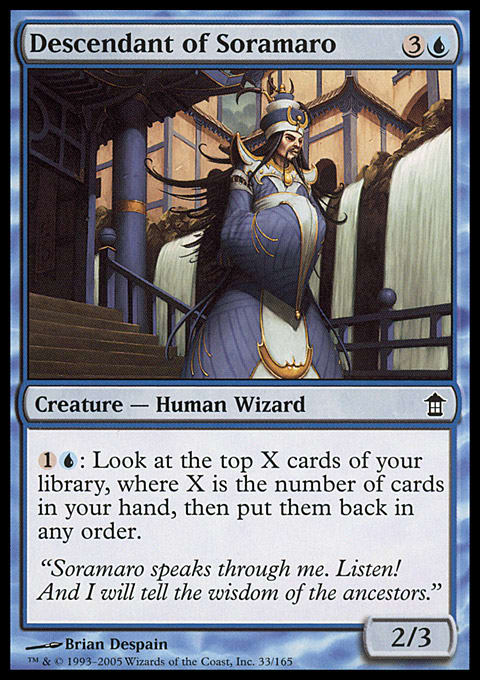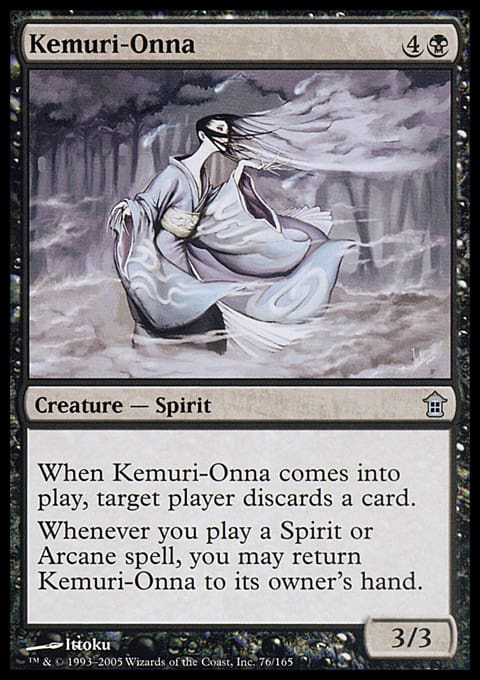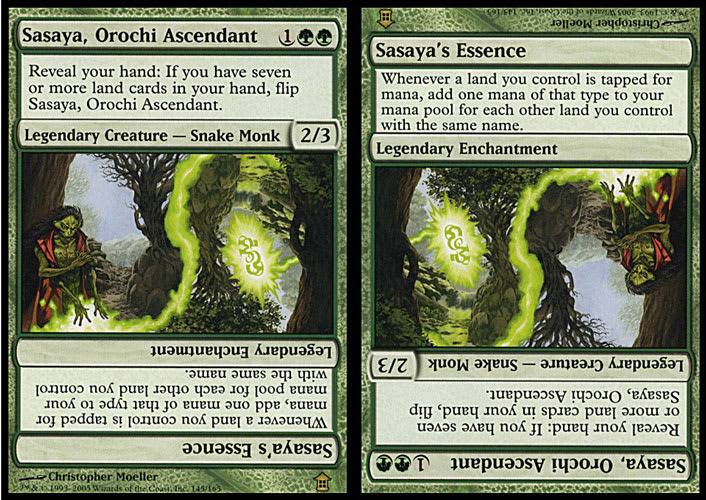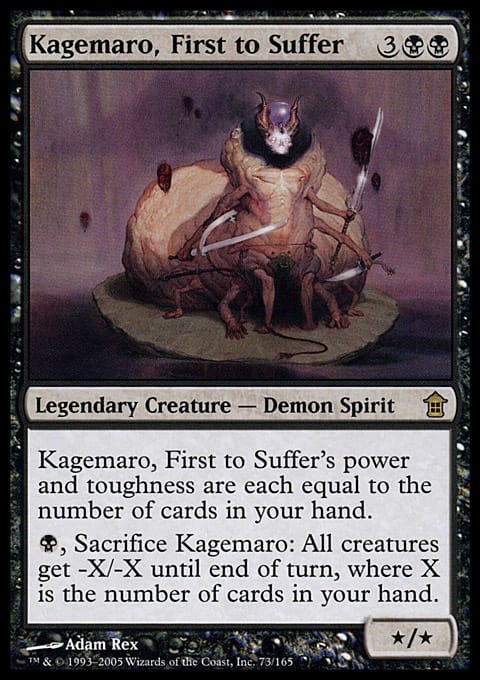Two weeks ago, I discussed the first two-thirds of the Kamigawa block. Quite randomly, Saviors of Kamigawa has eight uncommon/rare cycles, more than any small set apart from Eventide. Why? I don’t know. While cycles ideally are memorable, they can’t turn a bad set good, and while the Saviors cycles get points for effort, they aren’t bust-down-the-doors awesome, creating a tough sell.
A reminder of the parameters:
- I’m looking at horizontal cycles (Titans), not vertical cycles (Penumbra Bobcat/Penumbra Kavu/Penumbra Wurm). They need at least five cards, though they don’t have to be in five colors.
- No all-common cycles. They tend to be boring.
- No land/mana cycles. They tend to be too similar for my purposes. Besides, every dual land is good.
I’m grading each cycle on three categories:
- Playability – Does this cycle have any cards people want to play?
- Depth – Was it hit-or-miss or strong overall?
- Resonance – Memorable cycles should be able to pass the flavor test, although some cycles are mechanical and are not intended to have shared flavor. Still, making all the cards cost the same, have similar names, or share other characteristics can make a cycle memorable when it otherwise wouldn’t be.
Here goes nothing . . .
Ghost-Lit Things
(Ghost-Lit Redeemer, Ghost-Lit Warder, Ghost-Lit Stalker, Ghost-Lit Raider, Ghost-Lit Nourisher)
Playability: C
Depth: B+
Resonance: B−
Designed presumably for Limited (hard to tell with Saviors), the Ghost-Lit creatures are cheap Spirits with a tap ability and the channel ability word, which provides the option to discard the creature for a spell effect related to the tap ability. Outside a soulshift deck, it’s hard to justify using any of them. The abilities aren’t the problem; it’s the mana necessary to use them. I’ve wanted to use Ghost-Lit Stalker—repeatable Mind Rot is attractive—but paying ![]()
![]() per activation is rough, especially at sorcery speed and as a 1/1. Among channel creatures, common Shinen of Life's Roar seems to outdo the whole cycle.
per activation is rough, especially at sorcery speed and as a 1/1. Among channel creatures, common Shinen of Life's Roar seems to outdo the whole cycle.
There’s no flavor text to tell you what’s going on. It appears from the name and art that each creature can release its ghosts as the channel effect, which is a neat concept, but that’s all we know. This article might be the most anybody’s said about this cycle, and that should remain the case.
The Undermaros
(Descendant of Kiyomaro, Descendant of Soramaro, Kagemaro's Clutch, Gaze of Adamaro, Descendant of Masumaro)
Playability: B
Depth: C
Resonance: D
As a cycle, this is awful. You have a three-and-two split between both creatures and noncreatures and uncommons and commons, but those splits don’t match up. Apart from being Arcane, Gaze of Adamaro is Sudden Impact but with a heavier red commitment, and the Descendants are all somewhat playable, Soramaro’s being the most broadly usable for creature type and high-upside ability. But the cycle doesn’t feel tied to the legends naming them, its cards don’t feel tied to each other, and the best cards are decent. No rings of endorsement here.
I Won’t Go Onnabout Them
(Nikko-Onna, Kiri-Onna, Kemuri-Onna, Yuki-Onna, Haru-Onna)
Playability: B−
Depth: B
Resonance: C
Maybe these have more resonance if you know Japanese lore. They’re all small Spirits with enters-the-battlefield effects and the potential for frequent reuse. As with the Ghost-Lit cycle, I don’t like the mana commitment needed to break these creatures. Haru-Onna is green and draws a card; for Spirit-heavy decks, it fills the Masked Admirers role. Nikko-Onna is the cheapest of the cycle and therefore is easier to abuse, although destroying an enchantment isn’t always necessary. I’m trying not to judge them too harshly since they’re not my style.
The Creatures Inspired by Stampeding Wildebeests, Which Is in the Cycle, Except under a Different Name
(Eiganjo Free-Riders, Trusted Advisor, Skull Collector, Oni of Wild Places, Stampeding Serow)
Playability: B
Depth: C
Resonance: C (strictly mechanical)
If they were going to make a cycle around Stampeding Wildebeests but couldn’t put wildebeests in a Japanese context, could they at least not have made a functional reprint that is also an Antelope Beast? I’m all for more Antelopes in Magic, but I’m not looking for eight of the same Antelope.
Rant aside, these are undercosted creatures with a semi-drawback of returning a color-specific creature to your hand. These cards are as good as the things you’re reusing, and although it’s not my favorite cycle, I’ve used a few of them to good effect. Stampeding SeroWildebeests does good work with Where Ancients Tread; in that combo, you don’t mind the Antelope bouncing itself, so it’s extra value. When I had a Venser, Shaper Savant Commander deck, Trusted Advisor was phenomenal; in tandem with Sunken Hope and similar effects, Venser rarely was cast from anywhere besides my hand. It didn’t hurt to have a maximum hand size of nine either.
I don’t have much experience with the others, but the two I’ve used have been worthwhile even if narrow. It doesn’t explain the Antelope thing, but oh well.
The Ascendant Has Two Faces
(Rune-Tail, Kitsune Ascendant, Erayo, Soratami Ascendant, Kuon, Ogre Ascendant, Homura, Human Ascendant, Sasaya, Orochi Ascendant)
Playability: A
Depth: B
Resonance: B
The only flip creatures allowed as Commanders, they also comprise one of the best cycles in the block. Erayo is so playable that she’s banned as a commander, but she also was part of a late take on affinity decks in Extended that’s mostly legal in Modern. Olivier Ruel took fifth at Grand Prix: Copenhagen 2005 with it:
"Erayo Affinity"
- Creatures (21)
- 2 Myr Enforcer
- 3 Arcbound Ravager
- 4 Arcbound Worker
- 4 Frogmite
- 4 Ornithopter
- 4 Erayo, Soratami Ascendant
- Spells (22)
- 2 Cabal Therapy
- 4 Thoughtcast
- 2 Scale of Chiss-Goria
- 3 Pithing Needle
- 3 Talisman of Dominance
- 4 Chromatic Sphere
- 4 Cranial Plating
- Lands (18)
- 2 Underground River
- 4 Blinkmoth Nexus
- 4 Darksteel Citadel
- 4 Seat of the Synod
- 4 Vault of Whispers
Yes, with Erayo and Pithing Needle, Saviors of Kamigawa contributed loads of cards to affinity decks. Because that makes sense . . . anyway, the idea was that Erayo could be flipped very quickly, establishing tempo dominance.
Ultimately, most of the flipped abilities (the flipping turns the legends into enchantments as well) are as absurd as Erayo’s. Rune-Tail, Kitsune Ascendant is easily flipped in both Commander and Two-Headed Giant, Homura, Human Ascendant flips to a global Shiv's Embrace, and Sasaya, Orochi Ascendant offers the highest reward. In fact, in forty seconds, I made a Sasaya deck just now:
"Sasaya It Ain’t So"
- Creatures (4)
- 4 Sasaya, Orochi Ascendant
- Spells (4)
- 4 Treasure Hunt
- Lands (52)
- 4 Dryad Arbor
- 4 Kessig Wolf Run
- 44 Other lands that are good
See, that wasn’t hard, was it? My point is that it’s worth breaking this cycle, and since they start off legendary, you can break them as commanders. As for Resonance, their names on both sides convey their design much better relative to other flippers, and they’re also the only things that flip into enchantments, so they win uniqueness points as well. This cycle is so interesting that it’s hard to believe it’s in Saviors.
The Kirins
(Celestial Kirin, Cloudhoof Kirin, Infernal Kirin, Skyfire Kirin, Bounteous Kirin)
Playability: B+
Depth: A−
Resonance: B+
Gaining resonance off its unique creature type (and the double-color commitment), the cycle is made of legendary flying Kirin Spirits with some of the best “spiritcraft” triggers (“Whenever you cast a Spirit or Arcane spell”), if not the best. Since all the triggers key off the converted mana costs of your spells, they’re finicky to build around, as normal curve considerations work against them slightly.
My Karador, Ghost Chieftain Commander deck is tribal Spirits, and I have the three on-color members of the cycle in it. In the early game, I almost always tutor first for Celestial Kirin, as it changes how everybody plays. Suddenly, nobody wants to have too many permanents of the same converted mana cost; that’s not something players are used to caring about, and novel situations normally favor the one who created them. (Fun fact: Since Celestial Kirin doesn’t specify it destroys nonland permanents, it, Conspiracy set to Spirit, and Ornithopter makes a free Armageddon.) Infernal Kirin is hit-or-miss but a solid threat, while Bounteous Kirin starts gaining me 5 or 6 life per spell in the late game, which is a phenomenal recovery rate. All three synergize with Karador in that I normally have a graveyard of varied mana costs to trigger what I need. With a sympathetic deck, the Kirin cycle is powerful, and it’s decently flavored. Another job well done.
These Spells Are Epic, Man
(Enduring Ideal, Eternal Dominion, Neverending Torment, Undying Flames, Endless Swarm)
Playability: A−
Depth: C
Resonance: B (for uniqueness)
Here’s an oddball group. Epic is one of the ultimate deck-building challenges—can you maximize the effect of that spell to the point that it’s worth playing nothing else? For a couple, the upside turns out to be pretty high. Enduring Ideal was the basis of a creatureless Extended deck that killed with Form of the Dragon and stayed alive with Solitary Confinement. The decks looked bizarre on paper but performed pretty well. In casual, I’ve seen it combo nicely with Elfhame Palace in a deck that wanted to animate its lands. Skipping your draw to the Palace isn’t a drawback when you can’t cast spells and want to find lands.
Speaking of Form of the Dragon . . . my only Endless Swarm story involves a friend’s casting it in a casual game and making it up to about forty-one Snakes . . . which was fine except that his opponent had Form of the Dragon and Grip of Chaos. So, Form of the Dragon was picking its targets at random among forty-one Snakes and two players. There aren’t efficient ways with basic dice to roll among forty-three targets. It was hilarious, of course.
As for Undying Flames, its most infamous use is with Ink-Treader Nephilim, as copying an epic spell will give you multiple copies of the spell on subsequent upkeeps. The idea is to create enough copies the first time to burn opponents out the next time. I’ve seen this happen in casual as well, and it too is hilarious.
In casual and to a lesser extent in tournaments, epic spells lived up to their billing. They’re not always good, but they are among my favorite memories. That’s a pretty good legacy.
The Maros
(Kiyomaro, First to Stand, Soramaro, First to Dream, Kagemaro, First to Suffer, Adamaro, First to Desire, Masumaro, First to Live)
Playability: B+
Depth: A
Resonance: B+
Tying Kamigawa flavor into preexisting Magic flavor, the Maros are the best exemplars of Saviors’s wisdom mechanic: keeping cards in hand to strengthen your battlefield. All of them are usable, although Kiyomaro’s probably seen the least play. Kagemaro’s sacrifice effect has made it good across formats, Adamaro was key in Standard red aggro as a huge vanilla creature and is one of my favorite Commander vanilla creatures for scaling nicely against typical blue decks, Soramaro heads what is probably my best Commander deck, and I’ll never disrespect Masumaro after all the times my wife’s beaten me with it. (FYI: Shadow Rift’s a good card.)
The Maro connection is crucial in making this cycle work. By being legendary Spirits that showcase the block mechanic, there’s no problem with putting these in their set. But the Maro patronymic is a nod to Magic outside Kamigawa, which, given the block’s flavor intensity, is welcome. I like Kamigawa block, but it was a very immersive setting with a lot of appeal standing or falling on its flavor, and not everyone reacted favorably to it. The Maros bridge the gap gracefully, clearly belonging to their block but with flavor porting easily to other settings. It’s an elegant moment in creative conception.
Conclusion
Saviors of Kamigawa is one of the least-loved sets from the decade I’ve been playing. As with the rest of the block, the rare cycles fare well, but the uncommons seem a little worse this time. The rares have settled into Commander use, but that’s about it. It feels as though the design process was, “Here are some sweet rares! Now what?” Card design is relatively easy; set design is quite difficult. Saviors cycles show that off all too well.



























